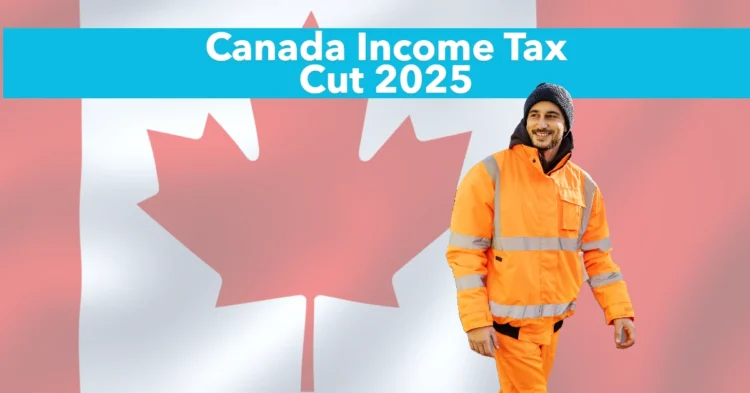In a significant effort to tackle inflation, ease financial pressure on households, and boost consumer spending, the Canadian government has introduced a major Canada income tax cut that will come into effect starting July 1, 2025. This pivotal tax reform lowers the lowest federal marginal income tax rate from 15% to 14%, marking the first cut to the base rate in years.
Table of Contents
Designed to benefit nearly 22 million Canadians, the move will offer tax savings of up to $420 per individual and $840 for dual-income families starting in 2026. The tax cut is part of a larger strategy by Prime Minister Mark Carney’s administration to build a more affordable Canada and strengthen the middle class.
What Is the 2025 Canada Income Tax Cut?
The Canada income tax cut for 2025 focuses on the lowest marginal tax bracket, reducing the rate from 15% to 14%. This applies to taxable income up to $57,375 in 2025. For the second half of 2025, a blended rate of 14.5% will apply, eventually stabilizing at 14% in 2026.
Key Highlights:
- Effective Date: July 1, 2025
- New Tax Rate: 14% for the lowest bracket
- Savings:
- Up to $420 per year for individuals
- Up to $840 per year for two-income families
- Beneficiaries: ~22 million low- and middle-income Canadians
- Total Projected Savings: $27 billion over 5 years
Canada Child Benefit Set to Increase by 2.7% in July 2025: Amount, Eligibility & Payment Dates
Who Qualifies for the Canada Income Tax Cut?
The tax cut applies to Canadians in the two lowest federal tax brackets:
- First Bracket: Taxable income up to $57,375
- Second Bracket: Taxable income from $57,375 to $114,750
Those who fall into these categories will benefit either through reduced payroll deductions starting in July 2025 or when they file their 2025 tax returns in 2026.
Real-Life Examples: What Will You Save?
Here’s a look at how much everyday Canadians stand to gain:
1. Sarah, a Single Retail Worker
- Income: $45,000
- Savings: $320 per year
- Impact: Can be used for credit card payments or travel savings.
2. The Patels, a Dual-Income Family
- Combined Income: $90,000
- Savings: $640 per year
- Impact: Extra funds for home upgrades or children’s education.
3. Michael, a Part-Time Student
- Income: $20,000
- Savings: $70 per year
- Impact: Helpful for textbooks and public transit.
Why This Tax Cut Is a Big Deal
1. More Take-Home Pay
This is real, direct financial relief—less money taken from paycheques, more money for rent, food, or savings.
2. Boost to Local Economies
With more disposable income, Canadians are expected to spend more on retail, hospitality, and services, helping small businesses thrive.
3. Strengthens the Middle Class
The tax relief is squarely aimed at the income brackets most affected by inflation and housing stress.
4. Lowers Cost of Living Pressure
A few hundred dollars a year can help ease the growing pressure of rising grocery, transportation, and utility costs.
When Will You See the Savings?
July 1, 2025
If your income is subject to source deductions (like salary or pension), you’ll see lower taxes withheld starting July 1.
Spring 2026
If you’re self-employed or have income not subject to deductions, you’ll benefit when you file your 2025 return.
How to Prepare for the 2025 Canada Income Tax Cut
1. Check Your Pay Stub
Make sure your employer updates payroll deductions to the 14% rate starting July.
2. Adjust Your Budget
Plan where to direct the extra cash—toward debt, savings, or investments.
3. Maximize Credits
The tax cut aligns with non-refundable tax credits. Claim medical, tuition, and other eligible expenses to save more.
4. Consult a Tax Professional
Get advice on how this impacts RRSP, TFSA, and income splitting strategies.
5. Use the CRA’s Online Tools
Stay updated through the CRA’s official site and tax calculator tools.
How It Compares to Past Tax Cuts
| Year | Policy | Savings |
|---|---|---|
| 2016 | Middle-class tax cut (22% → 20.5%) | Up to $330 |
| 2019 | Basic Personal Amount increase | Up to $300 |
| 2006 | GST reduction (7% → 5%) | Indirect savings |
| 2025 | 14% income tax cut | Up to $840 |
The 2025 tax cut stands out for its scale, speed, and wide reach across the Canadian population.
Criticisms and Concerns
Despite widespread praise, some experts raise these points:
- Inflation may outpace savings for some households.
- High-income earners receive no benefit, raising fairness questions.
- Fiscal sustainability concerns over the $27 billion revenue drop.
Still, many economists argue the policy is a strong short-term solution for households struggling under rising costs.
Canada’s Tax Cut in Global Context
- U.S.: No major federal cuts in 2025
- UK: Focus on national insurance rather than income tax
- Australia: Stage 3 tax cuts for middle earners
Canada’s approach stands out for directly targeting lower income brackets and being implemented mid-year.
Part of a Bigger Plan for Affordability
The income tax cut is part of a larger package, including:
- $10-a-day childcare expansion
- Affordable housing programs
- Green energy tax incentives
- Canada Child Benefit Increase (CCB)
Combined, these efforts aim to make daily life more affordable while promoting economic resilience.
Final Thoughts: Why the 2025 Canada Income Tax Cut Matters
The Canada income tax cut is more than a number—it’s a policy built for real people. Whether you’re a student, a working parent, or a retiree, this tax break gives you a little more breathing room in a tough economy.
By saving up to $840 a year, you can invest, save, or spend in ways that improve your quality of life.
What You Can Do Now:
- Bookmark the CRA website
- Revisit your 2025 budget
- Talk to your HR or payroll department
- Share this news with friends and family
The future of your wallet just got a little brighter.

